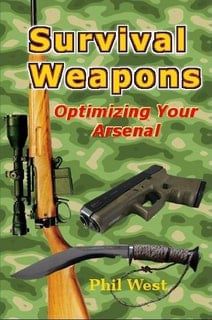By the Author of the Scrapboard : | |
|---|---|
 | Attack, Avoid, Survive: Essential Principles of Self Defence Available in Handy A5 and US Trade Formats. |
 | |
 | Crash Combat Fourth Edition Epub edition Fourth Edition. |
 | |
 | |
Added 15-3-2025
Updated 16-3-2025
Since its first use in the Vietnam War, the 40x46mmSR grenade cartridge has been adopted by a number of armies.
The round is not without its limitations, however.
• Each complete 40mm round weighs half a pound/230 g, limiting the quantity of ammunition that a grenadier can carry.
• If fired into snow or mud, 40mm rounds may not hit hard enough to detonate. Many models of round in use lack a self-destruct component. An undetonated round may explode when stepped on or driven over, making it a hazard to friendly advancing forces.
• Most models of 40mm explosive round have an arming distance of 14‑27 metres, which limits the use of the rounds in indoor or other urban operations. Some models of round had an arming distance of 2.4 to 3 metres, which is too short for safe use in certain environments.
• The casualty radius of the warhead is relatively small, being only five metres. This is much smaller than most hand grenades, or most other explosive weapons in common use. To be effective the round must be landed relatively closely to the intended target.
There are a number of obstacles to achieving such accuracy:
• The 40mm grenade round has a muzzle velocity of only 76 m/sec, projecting a grenade of around 180 grams mass.
This low‑velocity and relatively low sectional density makes the round very prone to the effects of wind. Cross winds will cause the round to drift. Head winds or tail winds may cause shots to fall short or long.
• The highly curved trajectory of the round makes an accurate judgement of the range important. The high trajectory is also a hindrance when operating under tree canopies or within large enclosed structures.
• The long time of flight also makes it difficult to engage moving or fleeting targets.
• Most launchers are single-shot and must be reloaded between each aiming and firing. This makes it difficult to “walk” rounds on to a target, even if sufficient ammunition is available.
Interestingly, the Russian equivalent (GP-25, GP-30 or GP-34) of the American 40x46mmSR system also uses 250-300 g rounds at a muzzle velocity of 76 m/sec. Due to a different mechanism, the entire round is fired as the projectile.
While a similar range to the American round is reported for this system, one wonders what effects the heavier round has on trajectory and time of flight. Casualty radius of the Russian round is reported as 6 to 9 metres.
Several weapon systems intended to replace the 40mm low velocity grenade launcher have been proposed.
Often these have come with a wish-list of desired features such as semi-automatic operation, air-burst mode and effective ranges of 1,000 metres or more.
As I discussed in my article on the .260 Rem/6.5mm Creedmore rifle rounds, sometimes finding a good solution depends on asking the right question in the first place.
As the Swedish study above notes, most squad-level combat occurs at under 200 metres.
In this light, is a grenade launcher with a range in excess of 400 metres really needed if it seldom, if ever, is it used at more than 300 metres?
Is it not more logical to optimize a weapon system for the ranges it will nearly always be used at?
Distant targets may be engaged by mortars and other systems far more capable than personal grenade launchers.
An effective range of around 400 metres for a squad-level grenade launcher seems more than adequate.
This is the range of existing grenade launcher systems, and allows grenade launcher fire to complement fire from squad machine guns.
The second question is that of round placement. What measures can be introduced to increase the chances of a grenadier placing a round close enough to an intended target to have an effect?
The Swedish study logically investigated means to reduce the flight time of a grenade projectile. Increasing muzzle velocity from 76 m/sec to 100 or 130 m/sec resulted in shorter times of flight and flatter lower trajectories. Standard mass (180 g) and heavier grenades (250 g) were trialled.
The Swedish study used grenades mounted in conventional 40x46mmSR cartridges. Alternate approaches might yield lower times of flight without penalties such as increased recoil.
Many large calibre weapons use a dual propulsive system.
A relatively small charge ejects the projectile from the barrel or launch tube. Several metres beyond the muzzle a booster or sustainer rocket ignites and accelerates the projectile to full velocity. The RPG‑7 is just one example of a widespread, successful weapon system that uses this mechanism.
The same design approach could be applied to 40mm grenade cartridges. The grenade is fired from the weapon using a hi-lo pressure launch system.
Some distance from the muzzle, when any initial yawing has settled, a small, fast burning rocket within the projectile ignites, boosting the velocity of the grenade.
A similar system is used to launch and propel the Pike munition from the M203/M320 launcher.
Such a launching system would obviously result in an increase in grenade mass. Since this mass gain would increase the sectional density of the faster moving projectile, this may be beneficial.
A dual propulsive system for launching grenades offers an intriguing possibility.
Suppose the grenadier can control whether or not the booster rocket is ignited.
The grenade might either be fired as a relatively fast, flat‑flying projectile, or fired as a low‑velocity, curved trajectory round that might be dropped behind an obstacle.
I call this concept for a potential 40x46mmSR replacement “Individual Medium Range Area Munition” or “IMRAM”.
If the IMRAM is to be made heavier than the current munition, the practicality of increasing warhead size should also be considered.

A warhead of around twice the size of existing 40x46mmSR rounds, with 70 to 90 grams explosive content might be optimal for the targets this is likely to be used against. A warhead this size produces a round with similar target effects to many muzzle-launched rifle grenades.
Any target that such a warhead cannot deal with would probably be more likely engaged with LAW/LASM or heavier weapons.
The MBDA TiGER used a dual 40mm grenade warhead massing around a pound (c.454 g). A prototype warhead for IMRAM might be constructed from a 40mm M433 HEDP and a M406/M441 HE.
Adopting a smaller calibre IMRAM might improve sectional density, with benefits to reducing time of flight and velocity decay. The desirability of an effective hollow charge capability excludes solutions with calibres of less than 30mm, however.
Many proposals for an M203/M320 replacement, including the Swedish study, suggest a dedicated, multiple‑shot weapon.
There are a number of objections to this approach, not least of which is the weight and bulk of such a weapon.
• A grenadier carrying such a weapon will be easily distinguished, and will become a priority target.
• The encumbrance of such a weapon prevents a grenadier carrying a rifle, or having a rifle available to use while operating the grenade launcher.
• The commonly proposed solution of incorporating a PDW into the grenade launcher is not satisfactory. Not only will this make the system a logistical orphan, but it utilizes a round of considerably less effectiveness than the often criticised 5.56x45mm rifle round.
If close range defence was the requirement, a shotgun built into the grenade launcher would be more logical, but the resultant system would be even more of an encumbrance.
A more logical approach, I feel, is that IMRAM should be a capability available to every rifleman, rather than a squad-level weapon with a dedicated operator.
Each IMRAM round would be issued in a carrying container that also serves as a one-use, disposable launcher.
This is a variation of the DGL system I have been proposing for several decades.
My original proposal for DGLs was that each round incorporate its own trigger unit. In order to reduce the load of the dismounted infantryman, IMRAM-DGLs do not have a trigger unit. This also serves as a control feature since rounds may only be fired from a properly configured rifle or other authorized compatible launch system.
For rifles, a replacement fore‑end unit will incorporate the necessary control systems to utilize the IMRAM and any other DGLs.
To use, the IMRAM‑DGL tube is mounted on a rifle fore‑end using a Picatinny rail. A connector, possibly of a type similar to “anyway up” design of a USB-C is inserted into a port in the DGL. This connection provides the DGL with a firing impulse, power and any pre-firing programming.
Potentially, a rifle with more than one Picatinny rail could mount multiple DGLs. This option might be used when fighting from vehicles or static positions.
The proposed OCSW and OICW were to use projectiles with programmable air-burst fusing.
The distance to the intended target was determined by an integral laser rangefinder and the projectile automatically programmed to explode at a set distance, over a trench or within a room, for example.
This capability has now been incorporated in certain cannon rounds and in ammunition for 40x53mmSR automatic grenade launchers.
As the Swedish study suggests, this would be a useful capability for 40x46mmSR weapons or their replacement.
Many rifles with underbarrel grenade launchers (UGL) are already fitted with laser rangefinders.
The Israeli Refaim system takes this a step further by incorporating a fire control system (FCS). The distance to the target is determined by laser, and the fire control system generates an adjusted aiming point on the sighting display. This system is compatible with muzzle-launched rifle grenades and underbarrel grenade launchers.
The control system for IMRAM would include a laser rangefinder and the option to program the round with various modes of air-burst, and either high‑or low‑velocity flight.
While an individual IMRAM will be heavier and larger than a single 40x46mmSR round, this is offset by the elimination of the need for a mounted underbarrel grenade launcher.
The increased hit probability and target effect of IMRAM will mean the same effects can be achieved with less rounds expended.
In addition, IMRAM rounds may be carried and utilized by all riflemen in a squad, rather than the majority of the ammunition being with a dedicated grenadier.
The overall number of rounds carried by a squad may be higher, even though each individual rifleman may carry less rounds.
IMRAM allows several riflemen to simultaneously engage a target from several locations at once.
By the Author of the Scrapboard : | |
|---|---|
 | Attack, Avoid, Survive: Essential Principles of Self Defence Available in Handy A5 and US Trade Formats. |
 | |
 | Crash Combat Fourth Edition Epub edition Fourth Edition. |
 | |
 | |